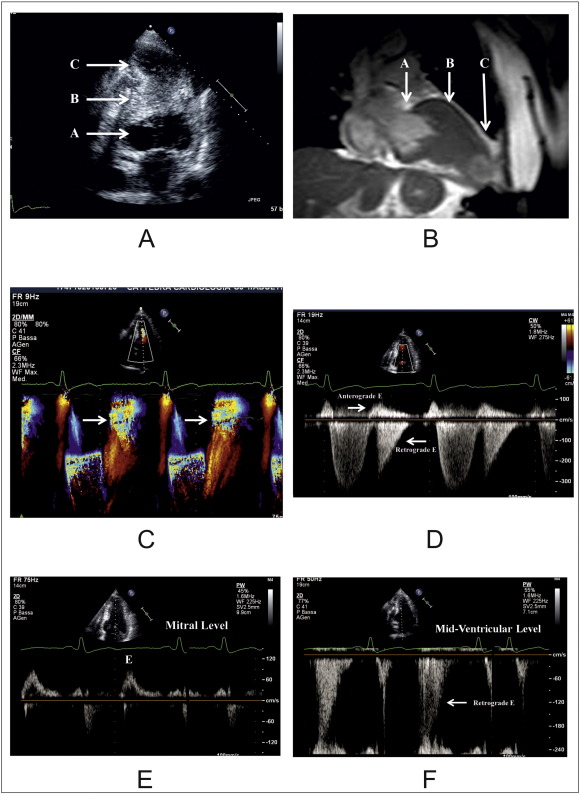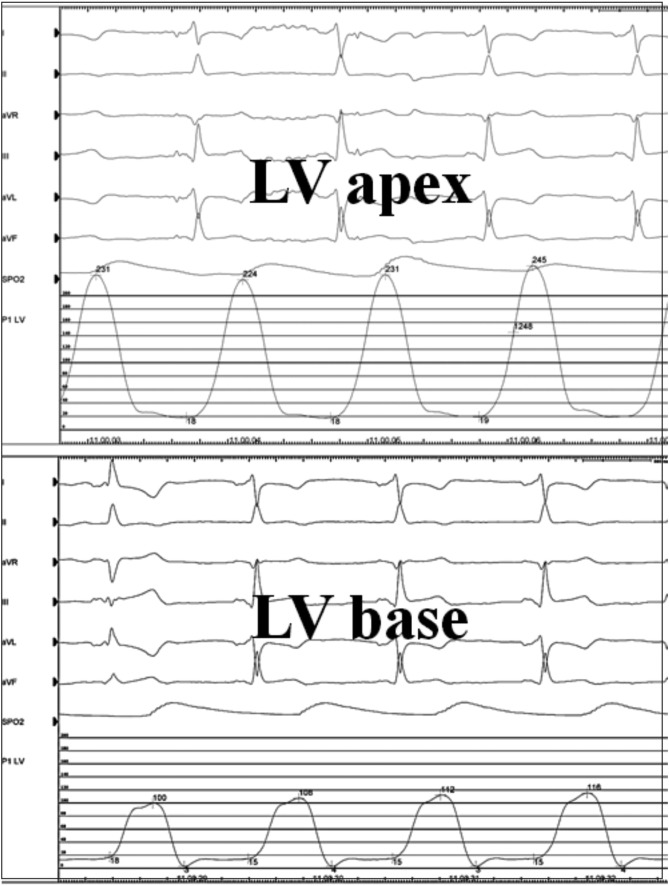Systolic left ventricular (LV) gradients and diastolic dysfunction are widely studied in hypertrophic cardiomyopathy (HCM) [1] ; [2], however diastolic gradients have never been described.
A patient with HCM, mid-cavity obliteration and apical aneurysm, diagnosed by both 2D echocardiography (Fig. 1, panel A) and cardiac magnetic resonance (Fig. 1, panel B), showed color Doppler aliasing effect at mid-ventricle toward the LV apex of early (E) diastolic velocity (Fig. 1, panel C). At continuous Doppler, E velocity resulted to be bidirectional (Fig. 1, panel D); pulsed Doppler identified the LV level at which E was highest (Fig. 1, panels E and F). The pullback pressure trace from LV apex to base, found a peak systolic gradient of 130 mm Hg, and a mean diastolic gradient of 10 mm Hg (Fig. 2). Such a gradient was of 15 mm Hg starting at early diastole and ending at meso-diastole, suggesting that apex fills during systole and empties during early diastole when the basal chamber has lower diastolic pressure.
|
|
|
Fig. 1. A) Two dimensional 4 chamber view, showing the basal left ventricular chamber (A), the mid-cavity obliteration (B), and the LV apical chamber (C). B) Cine balanced-fast field echo end-diastolic 2-chamber long-axis CMR view showing the basal left ventricular chamber (A), the mid-cavity obliteration (B), and the LV apical chamber (C). C) M-Mode color Doppler echocardiography in the 4 chamber apical view. E velocity shows aliasing effect starting at mid-ventricle the apex (arrows). D) Continuous Doppler in 4 camber view, showing that the early diastolic velocity is bidirectional within the left ventricle. E) Peak E velocity at mitral leaflet tip level. F) Peak E velocity at mid-ventricular level showing that at this level only retrograde high velocity E wave can be detected.
|
|
|
|
Fig. 2. LV pressure tracings: in top panel the end hole catheter is positioned in the apex, in bottom panel the end hole catheter is positioned in the base of the left ventricle. During the diastolic phase there is a pressure gradient between the apex and the base of 15 mm Hg. 129 ms after the beginning of the diastolic phase the pressure gradient is almost completely abolished. This is compatible with a diastolic flow from the apex to the base of the left ventricular cavity starting in early diastole and ending in meso-diastole.
|
Doppler LV mapping in diastole, may be useful to understand the pathophysiology of HCM, particularly in complex condition like that of mid cavity obliteration [3].
Furthermore, the impact of such a diastolic gradient on the response to exercise, reported to be a consequence of reduced cardiac output [4], may be of importance in the management of patients with HCM.
Conflicts of interest
None.
Acknowledgment
We thank Stefano de Maio for his technical assistance.
References
- [1] B.J. Maron, M.S. Maron; Clinical impact of contemporary cardiovascular magnetic resonance imaging in hypertrophic cardiomyopathy; Circulation, 132 (4) (2015), pp. 292–298
- [2] M.A. Losi, S. Betocchi, M. Chinali, et al.; Myocardial texture in hypertrophic cardiomyopathy; J. Am. Soc. Echocardiogr., 20 (2007), pp. 1253–1259
- [3] J.R. Po, B. Kim, F. Aslam, M. Arabadjian, G. Winson, D. Cantales, J. Kushner, R. Kornberg, M.V. Sherrid; Doppler systolic signal void in hypertrophic cardiomyopathy: apical aneurysm and severe obstruction without elevated intraventricular velocities; J. Am. Soc. Echocardiogr., 28 (2015), pp. 1462–1473
- [4] Q. Ciampi, S. Betocchi, M.A. Losi, A. Ferro, A. Cuocolo, R. Lombardi, B. Villari, M. Chiariello; Abnormal blood-pressure response to exercise and oxygen consumption in patients with hypertrophic cardiomyopathy; J. Nucl. Cardiol., 14 (2007), pp. 869–875
Document information
Published on 19/05/17
Submitted on 19/05/17
Licence: Other
Share this document
Keywords
claim authorship
Are you one of the authors of this document?


